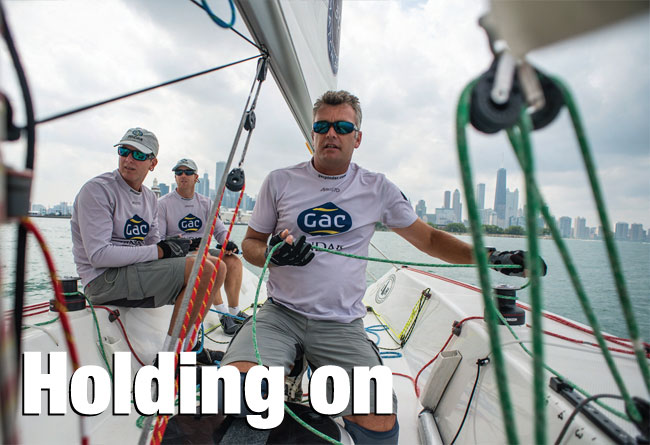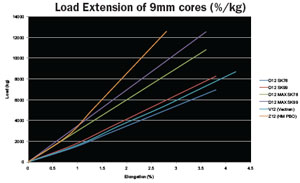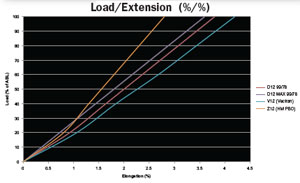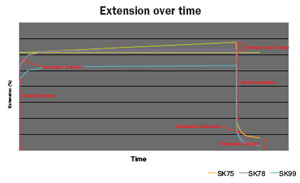

Why the latest Dyneema® products are better than ever...
The demands on high-performance running rigging are becoming higher and Marlow’s Grand Prix Series offers core options using Dyneema®, Vectran and Zylon (PBO). Each has its own strengths and weaknesses, but Dyneema® has become the ‘Gold Standard’ for performance running rigging.
Dyneema® is a HMPE (High Modulus Polyethylene), also known as UHMWPE or Ultra High Molecular Weight Polyethylene and is available in a number of different grades. All grades of Dyneema® have excellent fatigue resistance (cyclic bending) and UV, chemical and abrasion resistance, but all have poor heat resistance due to a relatively low melting point (150°C).
Dyneema® offers the best strength-to-weight ratio of any material used in rope manufacture, rivalled only by PBO, and is now the material of choice for high-performance cores. Marlow offer a range of Dyneema® cores to suit application preferences as well as budget. However, with new grades of Dyneema® being introduced and different treatments available, the decision as to which core is best can often be confusing.
- SK75 – for many years the strongest Dyneema® grade and the standard material that everybody understands. Thanks to new and improved grades, SK75 is being used less and less and is now not offered by Marlow.
- SK78 – has become the standard grade used by Marlow and other reputable manufacturers. SK78 has the same strength as SK75 but offers significantly improved creep characteristics than its predecessor.
- SK90 – launched in 2009 and offers approximately 10-15% strength improvement over SK75/8. However, SK90 only has the same elongation and creep characteristics as SK75. While still available, SK90 is now not specified by Marlow ropes due to the introduction of…
- SK99 – the latest offering from DSM Dyneema® launched in 2013. SK99 has 20% strength advantage over SK78 and crucially retains the same elongation and creep characteristics as SK78 – outgunning SK90 on all levels! SK99 has an unmatched strength-to-weight ratio and has carved a niche for itself as the ultimate performance core material.
- DM20 has slightly lower tenacity than SK78, but has one major advantage in that it exhibits virtually zero creep. Used mainly for static load applications such as standing rigging.

Another area of confusion can be heat-setting and prestretching. Every Marlow D12 Dyneema® core is pre-stretched to reduce ‘bedding-in’ elongation, limit the amount of elastic elongation and improve rope strength. Pre-stretching involves the application of heat during the process and is sometimes known as heat-setting, although simply applying heat does not have the same effect. Marlow have now been pre-stretching Dyneema® cores for over 25 years and that experience means we know exactly how to improve a rope’s performance without compromising flexibility or damaging the fibre.
Marlow’s MAX Technology takes pre-stretching to a new level by using a precisely controlled process to take Dyneema® to the limits of heat and load during the Pre- Stretching process – it could be called ‘Super Pre-Stretching’. D12 MAX ropes were introduced to offer the ultimate in strength realisation from Dyneema® and to virtually eliminate elastic and ‘bedding-in’ elongation.

D12 MAX ropes are stronger size for size than standard D12 – the MAX process packs more Dyneema® into the same diameter, hence the extra strength. However, D12 MAX ropes are stiffer and harder than the standard pre-stretched D12 ropes.
The graphs (opposite) show the relative elongation of Dyneema® SK78 and SK99 to Vectran and Zylon.
When elongation is measured as a % of break load (Fig. 2, middle), it is shown that while PBO offers the lowest elongation followed by Dyneema® in D12 MAX and then D12, there is no differential between SK78 and SK99.
However, when elongation is measured at a given load (for example, 4,000kg), which is more relevant to specifying rope for onboard applications (Fig. 1, top), the advantages of SK99 over SK78 in terms of elongation are clear. This is because the rope is working at a lower percentage of its break load.

Dyneema® exhibits creep, and it is important to understand how this affects a rope’s elongation characteristics. Creep can often have a negative effect on a rope’s performance and strength, when ropes are subjected to high loads for extended periods. The extension over time graph (Fig. 3, bottom) shows how Dyneema® ropes behave over a period of time.
- Initial loading will result in elastic extension. This is immediate upon loading and is immediately recoverable upon release of the load (elastic contraction).
- After the elastic extension of the initial loading the rope will experience what is known as viscoelastic extension. This is further extension over time and is fairly limited. Unlike elastic stretch, viscoelastic stretch will only recover slowly over time once the load is released.
- Finally there is creep, which is permanent, non-recoverable and time dependent. Creep occurs at the yarn molecular level when the rope is under constant load.
- Once the load is released and elastic and viscoelastic extension recovered the rope will ultimately have experienced an element of permanent extension. This is a factor of both creep and ‘bedding in’, which is when individual fibre components in the rope and/or splice settle into their preferred position when under load.
Marlow lead the market in performance yachting rope technology. Our Grand Prix Series offers performance benefits and a competitive edge… and is specified by winners!
Jon Mitchell, Managing Director
Click here for more information on Marlow Ropes»
We invite you to read on and find out for yourself why Seahorse is the most highly-rated source in the world for anyone who is serious about their racing.
To read on simply SIGN up NOW
Take advantage of our very best subscription offer or order a single copy of this issue of Seahorse.
Online at:
www.seahorse.co.uk/shop and use the code TECH20
Or for iPad simply download the Seahorse App at the iTunes store


